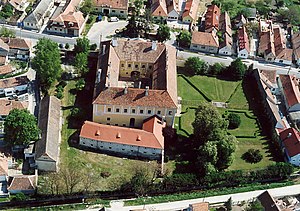Fertőrákos
| Fertőrákos | ||||
|
||||
| Basic data | ||||
|---|---|---|---|---|
| State : | Hungary | |||
| Region : | Western Transdanubia | |||
| County : | Győr-Moson-Sopron | |||
| District since 1.1.2013 : | Sopron | |||
| Coordinates : | 47 ° 43 ' N , 16 ° 39' E | |||
| Area : | 99.68 km² | |||
| Residents : | 2,146 (Jan. 1, 2011) | |||
| Population density : | 22 inhabitants per km² | |||
| Telephone code : | (+36) 99 | |||
| Postal code : | 9421 | |||
| KSH kódja: | 12414 | |||
| Structure and administration (status: 2014) | ||||
| Community type : | local community | |||
| Mayor : | János Palkovits (independent) | |||
| Postal address : | Fő u. 139 9421 Fertőrákos |
|||
| Website : | ||||
| (Source: A Magyar Köztársaság helységnévkönyve 2011. január 1st at Központi statisztikai hivatal ) | ||||
Fertőrákos [ ˈfɛrtøːraːkoʃ ] ( German : Kroisbach , Croatian : Krojspuh ) is a Hungarian municipality in Győr-Moson-Sopron County with 2,146 inhabitants (as of 2011). It is located on Lake Neusiedl ( Hungarian Fertő-tó ) about ten kilometers northeast of Sopron (German Ödenburg ) directly on the border with Austria . Today the community is part of the Austro-Hungarian UNESCO World Heritage “Fertő / Neusiedler See” and the Fertő-Hanság National Park .
A road on the Neusiedler See Cycle Path connects Fertőrákos with the Austrian municipality of Mörbisch am See, which is adjacent to the north . From there you can also drive to the state border, border controls have not taken place since 2008. The Mithras grotto is located directly on the Hungarian side of the state border , in which a Mithras relief from the Roman period of Pannonia can be seen, which was found before 1900 . Fertőrákos has a port facility and a seaside resort that was reserved for communist cadres until 1989 .
The village was first mentioned in 1199 with the name Racus . In 1457 it was first referred to in German as Krewspach , later as Kroisbach , and has belonged to the closed German-speaking area of western Hungary since the High Middle Ages (Hungarian census of 1880: 90.9% Germans, VZ 1920: 96.6%, VZ 1930: 96%). An archaeological find made in 1910 brought to light the Celtic coins of the so-called Kroisbacher type .
Fertőrákos (Kroisbach) was one of the five surrounding communities of Ödenburg, which in the 1921 referendum in Burgenland largely decided to join Austria, while Kroisbach with over 60% remained with Hungary due to the overall result of the vote. In 1945/46 most of the German-speaking residents were expelled to Austria and Germany. An Austrian estimate from 1970 assumed 10% German-speaking citizens.
The Wagner - Liszt Festival takes place every year in the Fertőrákos Cave Theater and in Sopron .
Kroisbach and the surrounding area at Lake Neusiedl, which dried up at the time (center left) (recording sheet of the state photo )
Treasure trove from the Latène period
East of Fertőrákos in 1910 a late Latène period vessel with about 100 to 120 silver tetradrachms was found. Since the find was destroyed, there are only 34 coins left in four different types. They are dated back to the 2nd or 1st century BC. And are seen by K. Pink as a stimulus for Norican coinage. 19 pieces are now in the coin cabinet of the Hungarian National Museum ( Magyar Nemzeti Múzeum ), four more in the coin cabinet of the Kunsthistorisches Museum in Vienna .
literature
- Karl Manherz: Linguistic geography and linguistic sociology of the German dialects in western Hungary. Böhlau Verlag Cologne - Vienna 1978, ISBN 3-412-03378-2
Web links
- Aerial photos of Fertőrákos
- Leonhard Alfred Pankraz Stopfer: The Celtic coins of the Kroisbacher group. Diploma thesis, Vienna 2014
Individual evidence
- ↑ K. Pink: The coinage of the Ostkelten and their neighbors. Braunschweig 1974; M. Torbágy: The Celtic coin find in Kroisbach (1910). Budapest 1999, p. 76 ff .; In: Susanne Sievers / Otto Helmut Urban / Peter C. Ramsl: Lexicon for Celtic Archeology. A-K ; Announcements of the prehistoric commission published by the Austrian Academy of Sciences , Vienna 2012, ISBN 978-3-7001-6765-5 , pp. 466–467.




